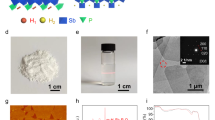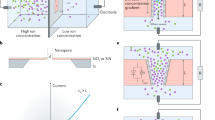Abstract
Modulated proton transport plays significant roles in biological processes1 such as ATP synthesis2,3 as well as in technologically important applications including, for example, hydrogen fuel cells4,5. The state-of-the-art proton-exchange membrane is the sulphonated tetrafluoroethylene copolymer Nafion developed by DuPont in the late 1960s, with a high proton conductivity6. However, actively switchable proton conduction, a functional mimic of the ion transport within a cell membrane, has yet to be realized. Herein, we report the electrostatic gating of proton transport within aligned mesoporous silica thin film. It is observed that surface-charge-mediated transport is dominant at low proton concentrations. We have further demonstrated that the proton conduction can be actively modulated by two–fourfold with a gate voltage as low as 1 V. Such artificial gatable ion transport media could have potential applications in nanofluidic chemical processors, biomolecular separation and electrochemical energy conversion.
This is a preview of subscription content, access via your institution
Access options
Subscribe to this journal
Receive 12 print issues and online access
$259.00 per year
only $21.58 per issue
Buy this article
- Purchase on Springer Link
- Instant access to full article PDF
Prices may be subject to local taxes which are calculated during checkout




Similar content being viewed by others
References
Decoursey, T. E. Voltage-gated proton channels and other proton transfer pathways. Physiol. Rev. 83, 475–579 (2003).
Noji, H., Yasuda, R., Yoshida, M. & Kinosita, K. Direct observation of the rotation of F-1-ATPase. Nature 386, 299–302 (1997).
Elston, T., Wang, H. Y. & Oster, G. Energy transduction in ATP synthase. Nature 391, 510–513 (1998).
Wang, C. Y. Fundamental models for fuel cell engineering. Chem. Rev. 104, 4727–4765 (2004).
Kreuer, K. D. Proton conductivity: Materials and applications. Chem. Mater. 8, 610–641 (1996).
Mauritz, K. A. & Moore, R. B. State of understanding of Nafion. Chem. Rev. 104, 4535–4585 (2004).
Stein, D., Kruithof, M. & Dekker, C. Surface-charge-governed ion transport in nanofluidic channels. Phys. Rev. Lett. 93, 035901 (2004).
Daiguji, H., Yang, P. D. & Majumdar, A. Ion transport in nanofluidic channels. Nano Lett. 4, 137–142 (2004).
Pu, Q. S., Yun, J. S., Temkin, H. & Liu, S. R. Ion-enrichment and ion-depletion effect of nanochannel structures. Nano Lett. 4, 1099–1103 (2004).
van der Heyden, F. H. J., Bonthuis, D. J., Stein, D., Meyer, C. & Dekker, C. Electrokinetic energy conversion efficiency in nanofluidic channels. Nano Lett. 6, 2232–2237 (2006).
van der Heyden, F. H. J., Stein, D., Besteman, K., Lemay, S. G. & Dekker, C. Charge inversion at high ionic strength studied by streaming currents. Phys. Rev. Lett. 96, 224502 (2006).
Karnik, R., Duan, C. H., Castelino, K., Daiguji, H. & Majumdar, A. Rectification of ionic current in a nanofluidic diode. Nano Lett. 7, 547–551 (2005).
Vlassiouk, I. & Siwy, Z. Nanofluidic diode. Nano Lett. 7, 552–556 (2007).
Siwy, Z., Heins, E., Harrell, C. C., Kohli, P. & Martin, C. R. Conical-nanotube ion-current rectifiers: The role of surface charge. J. Am. Chem. Soc. 126, 10850–10851 (2004).
Siwy, Z. & Fulinski, A. Fabrication of a synthetic nanopore ion pump. Phys. Rev. Lett. 89, 198103 (2002).
Siwy, Z., Kosinska, I. D., Fulinski, A. & Martin, C. R. Asymmetric diffusion through synthetic nanopores. Phys. Rev. Lett. 94, 048102 (2005).
Karnik, R., Castelino, K., Fan, R., Yang, P. & Majumdar, A. Effects of biological reactions and modifications on conductance of nanofluidic channels. Nano Lett. 5, 1638–1642 (2005).
Karnik, R. et al. Electrostatic control of ions and molecules in nanofluidic transistors. Nano Lett. 5, 943–948 (2005).
Daiguji, H., Yang, P. D., Szeri, A. J. & Majumdar, A. Electrochemomechanical energy conversion in nanofluidic channels. Nano Lett. 4, 2315–2321 (2004).
Goldberger, J., Fan, R. & Yang, P. D. Inorganic nanotubes: A novel platform for nanofluidics. Accounts Chem. Res. 39, 239–248 (2006).
Fan, R., Yue, M., Karnik, R., Majumdar, A. & Yang, P. D. Polarity switching and transient responses in single nanotube nanofluidic transistors. Phys. Rev. Lett. 95, 086607 (2005).
Nishizawa, M., Menon, V. P. & Martin, C. R. Metal nanotubule membranes with electrochemically switchable ion-transport selectivity. Science 268, 700–702 (1995).
Martin, C. R., Nishizawa, M., Jirage, K., Kang, M. S. & Lee, S. B. Controlling ion-transport selectivity in gold nanotubule membranes. Adv. Mater. 13, 1351–1362 (2001).
Reisner, W. et al. Statics and dynamics of single DNA molecules confined in nanochannels. Phys. Rev. Lett. 94, 196101 (2005).
Tegenfeldt, J. O. et al. The dynamics of genomic-length DNA molecules in 100-nm channels. Proc. Natl Acad. Sci. USA 101, 10979–10983 (2004).
Cao, H. et al. Fabrication of 10 nm enclosed nanofluidic channels. Appl. Phys. Lett. 81, 174–176 (2002).
Mao, P. & Han, J. Y. Fabrication and characterization of 20 nm planar nanofluidic channels by glass–glass and glass–silicon bonding. Lab Chip 5, 837–844 (2005).
Yang, P. D., Zhao, D. Y., Margolese, D. I., Chmelka, B. F. & Stucky, G. D. Generalized syntheses of large-pore mesoporous metal oxides with semicrystalline frameworks. Nature 396, 152–155 (1998).
Miyata, H. et al. Silica films with a single-crystalline mesoporous structure. Nature Mater. 3, 651–656 (2004).
Zhao, D. Y. et al. Triblock copolymer syntheses of mesoporous silica with periodic 50–300 angstrom pores. Science 279, 548–552 (1998).
Zhao, D. et al. Continuous mesoporous silica films with highly ordered large pore structures. Adv. Mater. 10, 1380 (1998).
Zhao, D. Y., Sun, J. Y., Li, Q. Z. & Stucky, G. D. Morphological control of highly ordered mesoporous silica SBA-15. Chem. Mater. 12, 275 (2000).
Wu, C. W., Ohsuna, T., Edura, T. & Kuroda, K. Orientational control of hexagonally packed silica mesochannels in lithographically designed confined nanospaces. Angew. Chem. Int. Edn 46, 5364–5368 (2007).
Wu, C. W., Yamauchi, Y., Ohsuna, T. & Kuroda, K. Structural study of highly ordered mesoporous silica thin films and replicated Pt nanowires by high-resolution scanning electron microscopy (HRSEM). J. Mater. Chem. 16, 3091–3098 (2006).
Yamauchi, Y. et al. Magnetically induced orientation of mesochannels in 2D-hexagonal mesoporous silica films. J. Mater. Chem. 16, 3693–3700 (2006).
Smeets, R. M. M. et al. Salt dependence of ion transport and DNA translocation through solid-state nanopores. Nano Lett. 6, 89–95 (2006).
Acknowledgements
This work was supported by the Air Force Office of Scientific Research, and the Division of Materials Sciences and Engineering, Office of Basic Energy Sciences, Department of Energy.
Author information
Authors and Affiliations
Corresponding author
Supplementary information
Rights and permissions
About this article
Cite this article
Fan, R., Huh, S., Yan, R. et al. Gated proton transport in aligned mesoporous silica films. Nature Mater 7, 303–307 (2008). https://doi.org/10.1038/nmat2127
Received:
Accepted:
Published:
Issue Date:
DOI: https://doi.org/10.1038/nmat2127
This article is cited by
-
Nanochannels and nanoporous membranes in reverse electrodialysis for harvesting osmotic energy
Applied Physics A (2022)
-
Improved osmotic energy conversion in heterogeneous membrane boosted by three-dimensional hydrogel interface
Nature Communications (2020)
-
Structure–property–function relationships of natural and engineered wood
Nature Reviews Materials (2020)
-
The synthesis of dandelion-like CuO nanoflowers and photocatalytic degradation of RhB
Colloid and Polymer Science (2017)
-
Incorporation of well-dispersed sub-5-nm graphitic pencil nanodots into ordered mesoporous frameworks
Nature Chemistry (2016)



